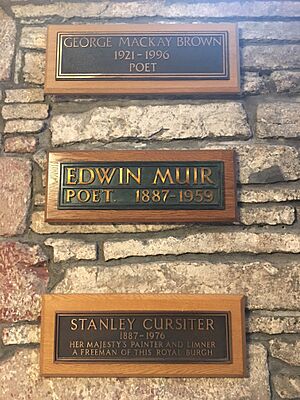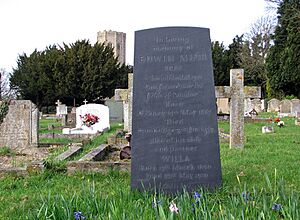Edwin Muir facts for kids
Quick facts for kids
Edwin Muir
|
|
|---|---|
 |
|
| Born | 15 May 1887 Deerness, Orkney, Scotland |
| Died | 3 January 1959 (aged 71) Cambridge, England |
| Occupation | Poet, novelist, translator |
| Language | English |
Edwin Muir CBE (born May 15, 1887 – died January 3, 1959) was a Scottish poet, writer, and translator. He was born on a farm in Deerness, a part of Orkney, Scotland. People remember him for his strong and clear poetry, which used simple language.
Contents
About Edwin Muir
Edwin Muir was born on a farm called Folly in Deerness. When he was 14, in 1901, his family lost their farm. They then moved to Glasgow, a big city. Edwin once wrote that he was an "Orkneyman, a good Scandinavian," showing his strong connection to his island home. Sadly, his parents and two brothers died within a few years of the family moving. As a young man, he had some difficult jobs in factories and offices.
In 1919, Edwin married Willa Anderson. They moved to London, and Edwin said his marriage was "the most fortunate event in my life." Edwin and Willa worked together on many translations, especially of books by Franz Kafka. They translated Kafka's famous book, The Castle, just six years after Kafka died.
Willa explained how they worked: "We divided the book in two. Edwin translated one half and I the other. Then we went over each other's translations very carefully." Willa was a very skilled linguist and did most of the translation work. Their translations helped them live between 1924 and World War II. They translated works by many important German writers. In 1958, Edwin and Willa received the first Johann-Heinrich-Voss Translation Award for their excellent work. Many of their translated German novels are still available today.
Between 1921 and 1923, Muir lived in several European cities like Prague, Dresden, and Vienna. He came back to the UK in 1924. From 1925 to 1956, he published seven books of poetry. These poems were later collected and published together in 1991. He also wrote three novels between 1927 and 1932.
In 1935, he moved to St Andrews, where he wrote a book called Scott and Scotland (1936). In 1939, also in St Andrews, Edwin became a Christian. He saw Christianity as a powerful and new way of thinking, similar to socialism. From 1946 to 1949, he worked for the British Council in Prague and Rome.
In 1950, he became the Warden of Newbattle Abbey College, a college for working-class men. There, he met another poet from Orkney, George Mackay Brown. Edwin Muir was given a CBE award in 1953, which is a high honor in Britain. In 1955, he became a professor at Harvard University in the United States. He returned to Britain in 1956 and passed away in 1959 in Cambridge. He was buried in Swaffham Prior, Cambridgeshire.

A special bench was placed in 1962 in Swanston, Edinburgh, to remember Muir. He had spent time there in the 1950s. His wife wrote a book about their life together in 1967. She lived for another eleven years.
Edwin Muir's Writings
Edwin Muir's childhood in the quiet and natural Orkney islands felt like a perfect "Eden" to him. When his family moved to the city, it felt like entering a difficult, "fallen" world. This strong difference between his peaceful childhood and his challenging city life shaped much of his writing.
He once wrote about this feeling: "I was born before the Industrial Revolution, and am now about two hundred years old. But I have skipped a hundred and fifty of them. I was really born in 1737, and till I was fourteen no time-accidents happened to me. Then in 1751 I set out from Orkney for Glasgow. When I arrived I found that it was not 1751, but 1901... No wonder I am obsessed with Time." This shows how much he felt disconnected from the modern world after leaving Orkney.
His personal struggles led him to explore his mind and feelings through a type of therapy called Jungian analysis. He had a powerful vision where he saw the creation of the world. This made him believe that his own life was like an archetypal story, a universal tale that everyone experiences in some way. He wrote that "the life of every man is an endlessly repeated performance of the life of man."
Key ideas in his work include feeling disconnected, seeing opposites like good and evil or life and death, and using images of journeys and mazes.
In his book Scott and Scotland, he argued that Scottish writers should write in English to create a national literature. This idea was different from what some other Scottish writers believed at the time. He also didn't strongly support Scottish nationalism.
In 1965, a collection of his best poems was put together and introduced by the famous poet T. S. Eliot.
His Lasting Impact

Critics have praised Edwin Muir's poetry for its lasting quality. Kathleen Raine wrote in 1961 that his poems "do not fade." She said that his poems are excellent because they don't depend on what was popular when he wrote them. She felt that while many "new" styles of poetry lose their meaning over time, Edwin Muir's work remains important because he didn't follow trends.
Joseph H. Summers also said that Muir's work was "larger than the merely literary." He believed that Muir understood there are things more important than literature, like life, love, and the natural world. Summers felt that Muir's success came from his deep understanding and wisdom, which he shared through his writing.
Books by Edwin Muir
- We Moderns: Enigmas and Guesses, under the name Edward Moore, 1918
- Latitudes, 1924
- First Poems, 1925
- Chorus of the Newly Dead, 1926
- Transition: Essays on Contemporary Literature, 1926
- The Marionette, 1927
- The Structure of the Novel, 1928
- John Knox: Portrait of a Calvinist, 1929
- The Three Brothers, 1931
- Poor Tom, 1932
- Variations on a Time Theme, 1934
- Scottish Journey, 1935
- Journeys and Places, 1937
- The Present Age from 1914, 1939
- The Story and the Fable: An Autobiography, 1940
- The Narrow Place, 1943
- The Scots and Their Country, 1946
- The Voyage, and Other Poems, 1946
- Essays on Literature and Society, 1949
- The Labyrinth, 1949
- Collected Poems, 1921–1951, 1952
- An Autobiography, 1954
- Prometheus, illustrated by John Piper, 1954
- One Foot in Eden, 1956
- New Poets, 1959 (edited), 1959
- The Estate of Poetry, 1962
- Collected Poems, 1965
- The Politics of King Lear, 1970
Books Translated by Willa and Edwin Muir
- Power by Lion Feuchtwanger, 1926
- The Ugly Duchess: A Historical Romance by Lion Feuchtwanger, 1927
- Two Anglo-Saxon Plays: The Oil Islands and Warren Hastings, by Lion Feuchtwanger, 1929
- Success: A Novel by Lion Feuchtwanger, 1930
- The Castle by Franz Kafka, 1930
- The Sleepwalkers: A Trilogy by Hermann Broch, 1932
- Josephus by Lion Feuchtwanger, 1932
- Salvation by Sholem Asch, 1934
- The Hill of Lies by Heinrich Mann, 1934
- Mottke, the Thief by Sholem Asch, 1935
- The Unknown Quantity by Hermann Broch, 1935
- The Jew of Rome: A Historical Romance by Lion Feuchtwanger, 1935
- The Loom of Justice by Ernst Lothar, 1935
- Night over the East by Erik von Kuehnelt-Leddihn, 1936
- The Pretender by Lion Feuchtwanger, 1937
- Amerika by Franz Kafka, 1946
- The Trial by Franz Kafka, 1937, reissued 1957
- Metamorphosis and Other Stories by Franz Kafka, 1961.

